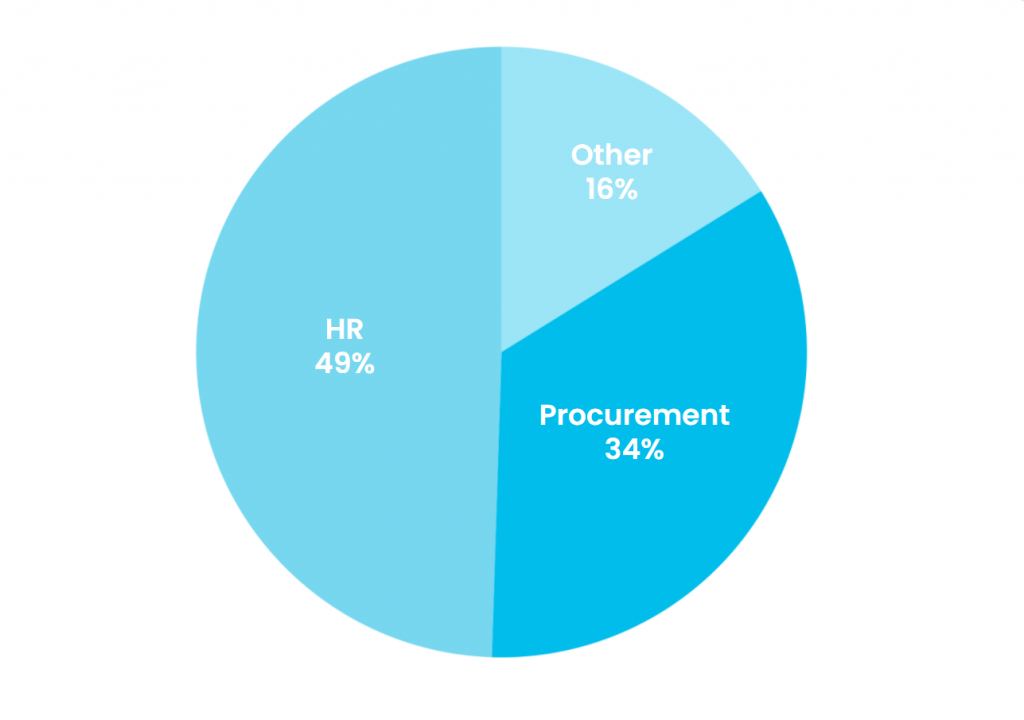
According to a recent Oxford Economics study, 83% of executives globally are increasing their contingent workforce programs (CWP). The evolving nature of workforce composition represents a major transformation for businesses worldwide. A significant shift in strategic requirements for people, process, and technologies is inevitable. Yet, with this, comes growing pains.
Percentage of executives around the world using contingent, seasonal, intermittent, or consultant employees.
There are many complexities that accompany the running of a successful contingent workforce program ranging across legal, compliance, supplier engagement and program innovations. This begs a vital question, who currently owns the CWP in your organization? Moreover, who should own your program as it evolves and why?
Procurement’s early leading role in contingent workforce management
As the department most in tune with contract negotiations and vendor management, Procurement initially took the lead on CWP ownership.
Consider the role of Procurement in your business and how this may relate to CWP ownership in years to come. Procurement at its core is “the act of obtaining goods or services, typically for business purposes. Procurement is most commonly associated with businesses because companies need to solicit services or purchase goods, usually on a relatively large scale”.
By sitting within Procurement, ownership of contingent workforce programs remains with the department who has expertise in obtaining competitive arrangements with recruitment agencies, payroll providers, Managed Service Providers (MSPs) and Vendor Management System (VMS) providers. For these reasons, Procurement was initially at the forefront of CWP ownership.
However, with the rapid rise in contingent workers, the nature of contingent workforce programs has evolved considerably to include more candidate attraction and engagement, employer branding and further alignment with diversity, equity, and inclusion goals. This indicates that greater involvement from HR would contribute to CWP success. In fact, this shift in ownership is currently being seen in businesses globally.
Human Resources contingent workforce program owners
The most recent Workforce Solutions Buyer Survey conducted by Staffing Industry Analysts’ found HR now owns more CWPs than procurement and is illustrated in the graph below.
Human Resources (HR) defined by Human Resources EDU is, “used to describe both the people who work for a company or organization and the department responsible for managing all matters related to employees, who collectively represent one of the most valuable resources in any businesses or organization”. The key word here is ‘employees‘.
While contingent workers are not employees, they are an increasingly integral part of your workforce. In some senses, this is why we are seeing a departure from the term ‘human resources’ and adoption of the term ‘people & culture’.
When HR takes ownership of the contingent workforce program it ensures expertise in worker engagement and legislation, incorporating them into the wider workforce while keeping in mind co-employment laws. Traditionally though, HR are not experienced buyers and expertise has to be learned in the area of contingent workforce program management. Thus, reinforcing the merits of a collaborative, inter-departmental approach to CWP operation for some organizations.
Who else could play a key role in contingent workforce management?
Whilst HR is the clear frontrunner for CWP ownership, it is important not to overlook the role of IT and Finance in management. IT typically plays a dominant role in the share of program spend. IT and digital roles are commonly the lion’s share of participants in any program, meaning they can play a key role in program ownership. Additionally, large enterprises can have their own CWP purely focused on IT roles, and this is managed within IT with the support of both Procurement and HR.
Finance is also due a noteworthy mention as it is not uncommon for the Procurement team to reside under Finance’s leadership. Finance can then bring financial insights into what is likely one of your business’s large investments.
Can how you measure CWP performance give us insight into who should own it?
By considering how performance is measured, we can gain insight into where ownership of contingent workers can sit. While there are many potential metrics, there are 3 core performance measures that typically come to the forefront:
- Program savings
- Internal stakeholder satisfaction
- Program management/development
Program savings: Any CWP owner will be measured on this, but it will take a collaborative approach to ensure that all potential savings are realized, while not to the detriment of the talent you bring into the business. Procurement can bring to the table experience in supply chain negotiations, while HR will have experience in talent attraction and engagement ensuring that you prevent salary creep as engaged candidates come to you.
Internal stakeholder satisfaction: Regardless of ownership, this will be a consistent measure. Program savings and program management & development performance can vary depending on who leads the program.
Program management/development: Procurement leading this performance measure will ensure that you receive a streamlined supply chain, strong commercial development and ongoing supplier engagement. On the other hand, HR experience will lend itself to developing worker engagement, onboarding, and wellbeing.
Each of these factors should be considered when looking at who owns the CWP in your organization.
External Ownership of Contingent Workforce Programs
While it is evident that ownership of the contingent workforce can sit across several roles internally, it is also critical to consider who can support your contingent workforce program from an outsourcing perspective thus, taking ownership and accountability for part of the program. Partners range from MSPs to recruitment agencies and technology partners such as direct sourcing platforms and VMS’.
When considering outsourced support, you also need to factor in your CWP model. As an example, if you were to have a global contingent workforce program you may decide to take on a hub and spoke service model with a center in New York or London, then local talent acquisition teams in regional countries. Bringing it to life with an example in the oil and gas sector, you may have in-country challenges, such as in regions like Iraq, Azerbaijan and Angola where you need to have them serviced from a centre typically through a local internal employee partner.
Read More: Why Invest in a Managed Direct Sourcing Solution
Why Question your Contingent Workforce Program Ownership
CWP is dependent on a number of factors both specific to your business and the wider workforce context in which you are operating. Considering your measurement of CWP success is a great way to gain insight into the results you are ultimately looking to see and therefore where management is best placed.
Whether you choose to follow current trends, placing ownership with HR, sticking with a more traditional Procurement-led model or another option altogether, the importance of creating a non-siloed culture that enables inter-departmental collaboration across HR, Procurement, Finance, IT and outsourced support will ultimately drive CWP success.
Whether your timeframes for review are annually or on a more ad-hoc basis, continuous improvement is key to all organizational success. You may have the sense your program isn’t ‘broken’ and it can be tempting to think while things are looking positive, you should leave them be. However, given the rapid rise of continent workers and implications of this for your business, addressing ownership upfront is the best time to look at improvements without the pressure to return quick fix results.
Get in touch with our team today to learn how LiveHire can help your organization with your Contingent Workforce Program.

